

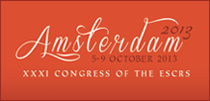 MAIN AMSTERDAM SITE
CONGRESS HIGHLIGHTS
GENERAL INFORMATION
PROGRAMME OVERVIEW
ONLINE EVALUATION
NEW FEMTO CATARACT
MAIN AMSTERDAM SITE
CONGRESS HIGHLIGHTS
GENERAL INFORMATION
PROGRAMME OVERVIEW
ONLINE EVALUATION
NEW FEMTO CATARACTThe XXXI Congress of the ESCRS was highly successful, with a record number of over 7,400 delegates attending from over 100 countries across the world.

The extensive scientific programme included 17 symposia, over 700 free paper presentations and 800 electronic poster presentations, and a wide range of didactic, instructional and wetlab courses. The 3rd ESCRS Glaucoma Day, organised by the European Glaucoma Society, was held on Friday and was also a great success.
The Congress was held in conjunction with the 4th EuCornea Congress and a Sub Specialty Day by World Society of Paediatric Ophthalmology & Strabismus and European Paediatric Ophthalmological Society, which brought a further 800 delegates to the RAI congress centre.
|
The Binkhorst Medal Lecture 2013 was delivered by Douglas Koch during a packed Opening Ceremony on Sunday, with the title ‘The Ablated Cornea: what have we done?’ This highly acclaimed lecture is free for all ESCRS members to view at www.escrsondemand.com |
In the 2013 Video Competition Makoto Kishimoto, Japan, won the overall Michael Blumenthal Award for his video ‘New type torsional phaco tip advantages’. All videos are available at www.escrsondemand.com. |
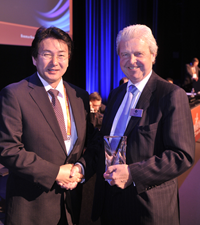 |
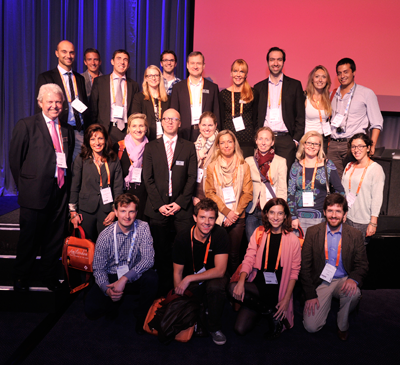 The annual Young Ophthalmologists Programme took place on Saturday under a new format which was implemented by the committee this year. The formatted programme saw expert presentations followed by the presentation of video cases by young ophthalmologists. A new Young Ophthalmologists Session was also introduced in Amsterdam and took place on Sunday morning. This new session focused on the topic of “Taking training into your own hands” and was aimed at highlighting the resources and opportunities available to young ophthalmologists to further enhance their training. Both sessions offered attendees the opportunity to text their questions directly to the chairpersons.
The annual Young Ophthalmologists Programme took place on Saturday under a new format which was implemented by the committee this year. The formatted programme saw expert presentations followed by the presentation of video cases by young ophthalmologists. A new Young Ophthalmologists Session was also introduced in Amsterdam and took place on Sunday morning. This new session focused on the topic of “Taking training into your own hands” and was aimed at highlighting the resources and opportunities available to young ophthalmologists to further enhance their training. Both sessions offered attendees the opportunity to text their questions directly to the chairpersons.
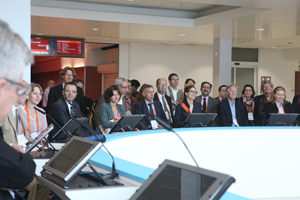 Interactive Poster Sessions were introduced for the first time in Amsterdam. These exciting new sessions took place on Sunday morning and Monday morning. The moderators presented a summary of each poster for 1 minute which was then followed by a 9 minute discussion between both the poster authors and the audience.
Interactive Poster Sessions were introduced for the first time in Amsterdam. These exciting new sessions took place on Sunday morning and Monday morning. The moderators presented a summary of each poster for 1 minute which was then followed by a 9 minute discussion between both the poster authors and the audience.
The NIOIC/ESCRS Video Symposium on Surgical Complications took place on Sunday afternoon. This symposium contained seven video cases which involved the participation of expert panellists and their first time reactions to the videos. The audience was asked to vote on their preferred course of action at several points throughout each case. As you can see from all of the above, the ESCRS has moved into a new era of interactive sessions. The emphasis on interaction is designed to help improve the learning experience for all delegates.

The annual President’s Dinner took place on Saturday night at the Beurs van Berlage, in Damrak which is located in the centre of Amsterdam. The building was originally designed as a commodity exchange by architect Hendrik Petrus Berlage and opened in 1903.
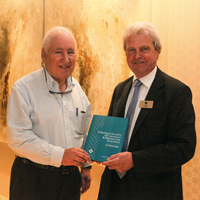
The ESCRS was delighted to introduce the official history book entitled “European Society of Cataract & Refractive Surgeons – A History” in Amsterdam. The book was edited by Emanuel Rosen and Peter Barry and looks into the development of the ESCRS from its introduction in 1982 to the present day.
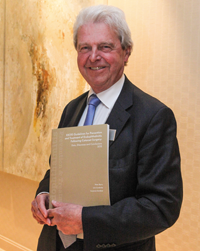
To follow on from the guidelines previously published in 2007, the ESCRS, with the help of Peter Barry, Luis Cordoves and Susanne Gardner, has also published a new 2013 “ESCRS Guidelines on Prevention, Investigation and Management of Post-Operative Endophthalmitis”.
We would like to extend our thanks to all speakers, delegates and exhibitors who attended the Amsterdam Congress and hope to see you all next year in LONDON 2014